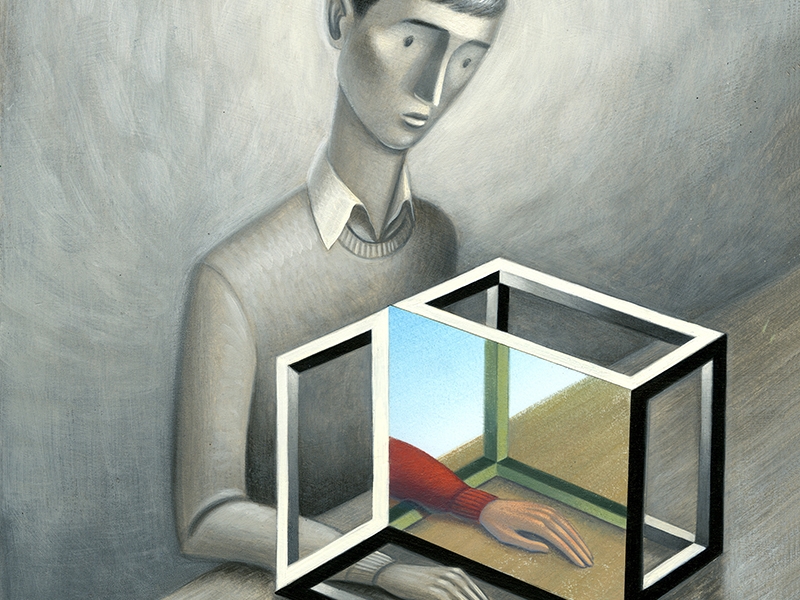Sleight of Hand
While some scientists scour the rainforest for new medicinal treatments, Eric Altschuler, associate professor of physical medicine and rehabilitation in the Lewis Katz School of Medicine, mines literature, music and art for medical discoveries. He’s very interested in mirrors, how they are depicted and how they are positioned in the composition of paintings. He points out that from 15th-century van Eyck through 20th-century Picasso, wherever a mirror appears in a painting, it’s portrayed and viewed by subjects on the frontal plane—that is, head on.
“It’s always the same,” Altschuler says, reviewing a slideshow of mirror images that the voracious arts enthusiast has collected. “All the way up until M.C. Escher in the 1940s, no one thought to look into a mirror differently.”
And likewise, no doctor ever considered that looking into a mirror in a specific way could play a role in medical treatment until the 20th century. At least not until Altschuler and his mentor Vilayanur S. Ramachandran pioneered mirror therapy.
TRICK OF THE EYE
To date, the deceptively simple technique has proven most successful for patients with phantom limb syndrome, a condition where one loses a limb but still feels its presence acutely, either through pain or a tingly, cramping or itching sensation. “The sensory nerves in the limb and brain still correspond so people still sense that limb as if it’s attached to the body,” Altschuler explains. “When the feeling is pain, it can be excruciating.”
During therapy, patients stand in such a way that the functioning limb is in front of the mirror and the injured or phantom limb is behind it. The angle, called the parasagittal plane, allows the patient to watch themselves
in the reflection. The very act of seeing the existing limb moving in the mirror creates a pulling or tense sensation that can “trick” the brain through sensory feedback into perceiving normal function in the injured or missing limb. After a few sessions of treatment, the spasming or pain often stops for good.
Positioning and geometry are everything, which is why it takes the help of a qualified therapist to assist patients with mirror therapy. “If a patient moved their nonfunctioning limb while merely looking at themselves in a mirror head on, the pain would be reinforced,” he says.
Ramachandran was the first to stumble on the concept of mirror therapy in the 1990s at the University of California San Diego, where Altschuler was a medical student. As Ramachandran’s protégé, he quickly saw its potential in helping patients with a range of orthopedic and neurological issues. In 1999, Altschuler published the first article about the burgeoning technique’s rehabilitative application for stroke patients in The Lancet.
Since ancient times, doctors had contended that stroke hemiparesis, or the inability to move one side of the body, was nearly impossible to treat. “They were able to perform brain surgery in ancient Egypt, but there has never been a treatment for stroke hemiparesis—something that affects millions of patients. The answer to the problem was never obvious,” Altschuler says.
Mirror therapy for stroke patients operates in the same way as it does for phantom limb sufferers. The affected side of the body gains more mobility from the process—though Altschuler points out that stroke patients don’t always get the same degree of relief as phantom limb patients.
NOT JUST SMOKE AND MIRRORS
With a number of studies proving the clinical benefits of mirror therapy, Altschuler brought it to amputees in Haiti after the earthquake to help reduce their pain symptoms. There, he worked with a woman who had lost a finger and could not hold a comb. The problem was twofold: It wasn’t just the phantom pain of her lost appendage; it was also the mechanical issue of not being able to close her fist fully. The treatment addressed both dilemmas.
Altschuler is now bringing mirror therapy to Walter Reed National Military Medical Center in Washington, D.C., to investigate its effects for patients with complex orthopedic and peripheral nerve injuries. Study participants, all combat veterans with injuries to two or more joints, muscles or nerves in the same limb, will be asked to undergo 15 to 30 minutes of therapy five or six days a week,both at the hospital and at home. The pilot study will examine whether the treatment reduces pain, spasms and stiffness while helping the patients regain mobility.
Mirror therapy has been widely adopted and is now used by physical therapists around the world. “The scientific literature is extensive, with more trials than many drugs on the market,” he says. He believes the therapy’s next frontiers might be reflex sympathy dystrophy and complex regional pain syndrome, conditions which affect many patients and—like stroke hemiparesis and phantom limb—are unresponsive to other treatments.
Recently Altschuler met a psychologist who had undergone surgery for a torn Achilles tendon and now suffers from reduced mobility as a result. Through mirror therapy, she was able to improve the function of her foot, and Altschuler has now submitted it as a case report to encourage further study. Though it’s not a magic solution for every patient, mirror therapy can be a powerful, inexpensive and safe means of pain relief that requires no drugs—just an item most people already have at home. It’s also great news for stroke or phantom limb patients who are suffering in silence.
“I’ve met people who have been living with pain for 10 or 20 years, only to hear that they must be crazy or making it up,” Altschuler says. “For people in that situation, I highly advise they see their doctor and ask about mirror therapy. It doesn’t help everybody, but it’s worth looking into.” Altschuler continues to look closely at art for insight into disease and treatment—the next great therapy may already exist in a story, a painting or a song. “You never know what you will find,” he says. “I just may stumble upon an answer to an unsolved problem.”
